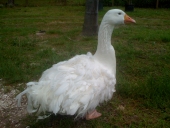
 2
2




 3
3




 1
1




Caitlin Mac Shim wrote:Hiya! Interesting idea!
Couple of things I would consider...
Depending on your climate, your Ducks might get a little toasty up there. Where I live it would be way too hot and muggy up there with geese in the bottom half too. Ventilation will be important - could you make the roof a bit higher?
Also, in the current design, the ducks need to make it past the geese (in close quarters) to get to the laying boxes. Might not be a problem if the geese are nice and the ducks are brave, but could be stressful for a duck that likes to lay as much as an Indian Runner to run the laying box gauntlet every morning. So, I’d add a laying box at duck level, or at least provide some straw for then to lay in on their level.
If you don’t have your heart set on IRs, Muskoveys might be worth looking into. They roost, like a chicken, and like to be up high, so might work better with your double decker design as long as the geese have some form of protection from muskovey projectile poo lol. They are a bit different to a mallard derived duck breed though.
Or, if your heart is set on IRs, what about making the coup longer, rather than higher? So it’s no wider and can get through your paths, but has a second space (chamber?) for the ducks at ground level? Would be easier to manoeuvre On hilly terrain with a lower centre of gravity but would be harder to get around tight corners. Would allow for a bigger space with better roof height/ventilation though.
I’ll keep thinking on it!
 2
2




Jd
 2
2




S. Bard wrote:
Hi Caitlin, thanks for your response. You make a couple of very valid points to consider.
As for my climate, I live in the Northern Alps. Summer can get nice and warm, but nothing too extreme. The creek that runs trough our property, which is a little valley in itself, cools down the temperature to a pleasant athmosphere. We also have a lot of tree cover, so the coop would never have to be in full sun. Nevertheless you comment on the ventilation is a good one. I will see if I can raise the roof a bit more, but right now I'm actually considering making both sides of the coop with mesh paneling, that can be closed partially or fully depending on the needs of the season.
As for your comment on the nesting boxes, that's a really good point I hadn't considered. I'll be raising both ducks and geese together from the eggs, so I'm hoping they will imprint on one another and cosider each other as family, but still. Maybe it would be an idea to build a separating wall with a hole too small for the geese to go through on the side where the ramp to the upper level is, and have the nesting boxes on that side of the coop so the geese can't get to them. Our geese only lay about 30 eggs a year, and if I'm not mistaking, they prefer a nest consisting of some hay on the ground, rather than a nesting box, so I might just give them a bit more hay to lay in in the egg-laying season? The only consequence would be that adding the hay to the bottom level would kind of defeat the purpose of the mesh bottom, and make cleaning out the hay more difficult.
I do have my heart set on IR to be honest. Might get some muscovites in the future, but those would be for meat production, while these IR would be more intended for their eggs, slug control, and just as pets because I'm so fond of ducks and the IR ducks are a treat to each.
I don't think making the coop much longer would be feasible as we have to make some sharp bends to navigate our terrain.
 1
1





|
Last year, this tiny ad took me on vacation to Canada
To Make a Farm – a film by Steve Suderman
https://permies.com/wiki/213795/Farm-film-Steve-Suderman
|



